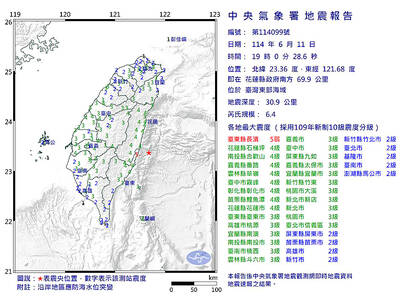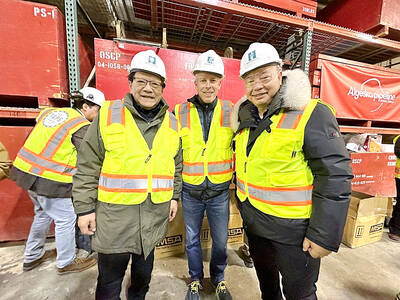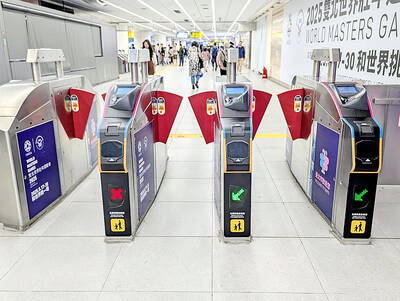The Maritime and Port Bureau said it would soon have tug boat operators standing by at the nation’s seaports to rescue and remove stranded ships.
The bureau issued the remarks last week after it was criticized for its handling of Chinese cargo ship Yu Zhou Qi Hang (鈺洲啟航), which had been stranded off the nation’s northeast coast before Super Typhoon Kong-rey made landfall on Oct. 31.
The Northern Maritime Affairs Center on Tuesday last week noticed that the ship was sailing at an abnormal speed and immediately began the emergency response by informing the National Rescue Coordination Center and the Coast Guard Administration of the situation, the bureau said.

Photo: Lin Chia-tung, Taipei Times
The ship’s 17 crew members were rescued by the coast guard, while the bureau assisted the ship owner in recruiting tug boat operators to help salvage the ship, it said.
However, the captain abandoned the ship on Tuesday night, although the anchor did not appear to have lost control of the ship, which resulted in the ship being stranded, it added.
The bureau also said it had finished blocking the ship’s oil tank and installing an oil containment boom in waters in Yehliu (野柳), Kueiho (龜吼), Dawulun (大武崙) and near the Guosheng Nuclear Power Plant, also known as the Second Nuclear Power Plant.
“We have retained a larger ship to pump out the oil on the ship when maritime weather conditions permit. We will continue to ensure that the oil containment boom is properly installed to protect the oceanic environment,” the bureau said.
Article 22 of the Commercial Port Act (商港法) stipulates that ships berthed inside commercial ports should immediately adopt emergency measures to prevent danger or depart from the port according to the instructions of commercial port authorities.
The Taiwan International Port Corp’s rules governing the berthing of vessels during typhoons also state that six hours before typhoons arrive at the Port of Keelung, the port’s emergency response team could suspend the exit and entry of ships after considering information from the Central Weather Administration and other agencies.
The rules also state that ships carrying dangerous goods, including oil tankers and chemical tankers, car carriers, container ships and ships with a deep draft that arrive in waters outside the port or are moored in the port should leave for shelter and are not allowed to stay.
That does not mean that the port authority in Keelung should ask all ships to leave without any exception, the bureau said.
“The cargo load of this ship was too large, the gravity center was too high and the height above the waterline was 70m, which is far higher than the height of a container ship,” it said.
“The ship’s captain knew it could not take shelter in the port and had submitted an application to leave for shelter. After assessing the situation, the company’s branch office in Keelung approved the ship’s application for departure from Keelung Port at 5:07pm on Monday last week,” the bureau said.
Based on the approval, the ship had to leave the Keelung Port 46 hours before the entry and exit control of the port began at 7:07am on Tuesday last week.
To improve the capacity to respond to maritime disasters, the Executive Yuan on Sept. 3 approved a plan to increase the capacity of emergency tow and rescue vessels in offshore wind farms, it said.
The plan would authorize the bureau to hire tug boats and rescue ships capable of withstanding winds of Level 8 on the Beaufort scale and waves of 4m to 6m to stand by at commercial ports, the bureau said.
The ships must also have more than 10,000 horsepower and a towing capacity of more than 150 tonnes, it added.

A magnitude 6.4 earthquake struck off the coast of Hualien County in eastern Taiwan at 7pm yesterday, the Central Weather Administration (CWA) said. The epicenter of the temblor was at sea, about 69.9km south of Hualien County Hall, at a depth of 30.9km, it said. There were no immediate reports of damage resulting from the quake. The earthquake’s intensity, which gauges the actual effect of a temblor, was highest in Taitung County’s Changbin Township (長濱), where it measured 5 on Taiwan’s seven-tier intensity scale. The quake also measured an intensity of 4 in Hualien, Nantou, Chiayi, Yunlin, Changhua and Miaoli counties, as well as

Credit departments of farmers’ and fishers’ associations blocked a total of more than NT$180 million (US$6.01 million) from being lost to scams last year, National Police Agency (NPA) data showed. The Agricultural Finance Agency (AFA) said last week that staff of farmers’ and fishers’ associations’ credit departments are required to implement fraud prevention measures when they serve clients at the counter. They would ask clients about personal financial management activities whenever they suspect there might be a fraud situation, and would immediately report the incident to local authorities, which would send police officers to the site to help, it said. NPA data showed

ENERGY RESILIENCE: Although Alaska is open for investments, Taiwan is sourcing its gas from the Middle East, and the sea routes carry risks, Ho Cheng-hui said US government officials’ high-profile reception of a Taiwanese representative at the Alaska Sustainable Energy Conference indicated the emergence of an Indo-Pacific energy resilience alliance, an academic said. Presidential Office Secretary-General Pan Men-an (潘孟安) attended the conference in Alaska on Thursday last week at the invitation of the US government. Pan visited oil and gas facilities with senior US officials, including US Secretary of the Interior Doug Burgum, US Secretary of Energy Chris Wright, Alaska Governor Mike Dunleavy and US Senator Daniel Sullivan. Pan attending the conference on behalf of President William Lai (賴清德) shows a significant elevation in diplomatic representation,

The Taipei MRT is to begin accepting mobile payment services in the fall, Taipei Rapid Transit Corp said on Saturday. When the company finishes the installation of new payment units at ticketing gates in October, MRT passengers can use credit cards, Apple Pay, Google Pay and Samsung Pay, the operator said. In addition, the MRT would also provide QR payment codes — which would be compatible with Line Pay, Jkopay, iPass Money, PXPay Plus, EasyWallet, iCash Pay, Taiwan Pay and Taishin Pay — to access the railway system. Currently, passengers can access the Taipei MRT by buying a single-journey token or using EasyCard,